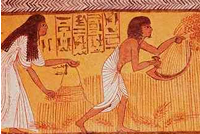 |
|
Harvest in ancient
Egypt |
The first century Greek historian Plutarch wrote that the ancient Egyptians would honour their deities with offerings of salted fish, lettuce and onions on the feast of Shamo during the spring harvest season. Shamo means ‘renewal of life’, and some rituals associated with it, such as the colouring of eggs, have become attached to the celebration of Easter.
During the Coptic
era Shamo became corrupted to Sham—‘sniffing’
or ‘smelling’—and the spring festival of Sham
El-Nessim (‘sniffing the breezes’) is the modern
version of this 4500 year old tradition.
The same foods that were consumed on Shamo are still eaten today. Lettuce
and malana—green chick pea shoots—symbolise the resurgence
of life; as they became plentiful during the receeding of the yearly Nile
flood, fish were also viewed as symbolic of fertility by the ancient Egyptians,
and salted fish—known as fisikh—is another regular
part of the meal on this day. Fisikh is prepared in traditional
processes handed down from one generation to another; the types of fish
used include sardines, mullet, mackerel and anchovies.
The festival of Sham El-Nessim occurs on the Monday after Coptic (Orthodox) Easter. It is a time to ‘take in the air’, and families will take trips to the countryside, visit parks and zoos, colour eggs and hold picnics. It is the modern recognition of an ancient practice that has survived the coming of the Jews, Christians and Muslims—a celebration of spring that can be shared by all modern Egyptians regardless of their religion.